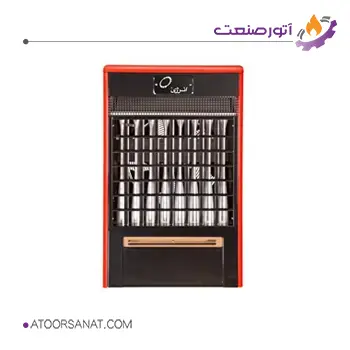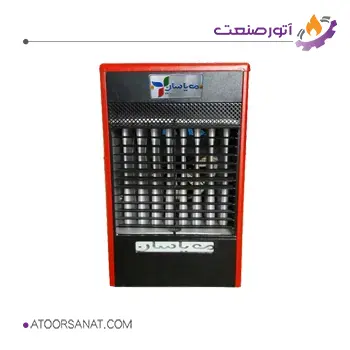Gas Industrial Heater

What is a Heater?
A heater or industrial heater is a heating device used to warm open, semi-open, and enclosed spaces in residential, commercial, and industrial settings. This industrial equipment has independent and direct heating systems and do not require central heating or a boiler room. These heating devices are available in three types based on their operation: fan-powered, fanless, and radiant; and in terms of energy source, they come in gas, oil, diesel, and electric varieties.
Fan-powered or cabinet heaters and industrial heaters are considered one of the best types of heating equipment during the cold seasons. These devices use natural gas or liquefied petroleum gas to heat the air, which is then circulated into the environment by a fan. Due to their low price and the availability of gas throughout the country, they are very popular.
In fanless heaters, such as oil and diesel workshop heaters, fans are not used for heat transfer. Similar to home heaters, they typically use a chimney to exhaust toxic and hazardous combustion gases.
Radiant heaters are another type of widely used industrial heater and, like the sun, heat the environment using the radiant heat transfer method. In this system, infrared waves are used for heating, and it is possible to direct the heat path. Therefore, individuals can be warmed without the need to heat the entire environment, resulting in energy savings. These devices are suitable for heating spaces with a height of 3 meters or more, such as poultry farms, warehouses, workshops, etc., and are available in both electric and gas types, although the gas type is more common due to the cost of electricity in the country.

Features:
- Country of Origin: Iran
- Input Heat Capacity: from 18,000 to 45,000 cubic meters
- Applications: For residential, commercial, industrial, and other uses.

Features:
- Country of Origin: Iran
- Input Heat Capacity: from 25,000 to 50,000 kcal per hour
- Applications: For commercial, industrial, workshop, and other uses.
Gas-Powered Fan Heater
A gas-powered fan heater is a type of industrial heater that provides heating and increases the temperature in the environment uniformly through forced convection. These heaters are manufactured in various capacities to be used in different environments with a wide range of sizes. Gas-powered fan heaters operate on natural gas or liquefied petroleum gas and usually have the option of converting the fuel from natural gas to liquefied petroleum gas, allowing for the use of liquefied gas or cylinders in areas where natural gas is not available. This equipment can be wall-mounted or placed on a stand.
To use this gas heater, the device must be connected to a fuel source and the burner ignited. The burner flame heats the furnace, causing the blower fan to start. As the fan circulates, cold air is drawn into the furnace, heated, and blown into the environment, while the combustion fumes, including carbon monoxide, are exhausted through the chimney. Gas-powered fan heaters are used to heat commercial, recreational, and industrial environments such as workshops, mosques, restaurants, auditoriums, sports stadiums, greenhouses, and more.
Components of a Gas-Powered Fan Heater:
The main components of a gas heater include:
- Body: The body encloses all the components of the heater and is usually made of metal and coated with an electrostatic paint to resist rust and corrosion.
- Burner: The burner is responsible for producing heat in the heater and its power depends on the heating capacity of the heater.
- Blower fan: The blower fan is responsible for drawing in cold air and transferring it to the environment.
- Thermostatic valve: This component controls the temperature of the air exiting the heater with the help of a thermostat and plays a role in optimizing fuel consumption.
- Fan thermostat: This component is used to control the activation of the blower fan after the furnace is heated and prevents the transfer of cold air to the environment.
- Chimney: The chimney directs the combustion fumes to the outside environment.
- Control valve: The control valve is responsible for regulating the amount of gas entering the burner.
- Damper (movable flap): This flap allows the user to adjust the direction of the hot air and is installed at the air outlet.
Industrial and Workshop Oil and Diesel Heaters:
Industrial and workshop heaters are some of the most widely used heating devices, employed to warm large spaces such as industrial halls, farms, sports clubs, and more. These industrial equipment generate heat steadily through convection and typically use oil, gas, or diesel as fuel.
The oil and diesel types are suitable for areas where natural gas is not accessible and the fuel source is a tank, while the gas types are connected to the city gas supply through gas connections including hoses and valves. These heating devices are suitable for environments that lack adequate ventilation, and the installation of a chimney in enclosed spaces is mandatory. Due to the use of standard components, these heaters have high heating efficiency and optimized fuel consumption.
These industrial equipment are selected based on the square footage and ceiling height of the desired environment and the regional climate. They are produced in various capacities according to the consumer’s needs. Capacity or heating power in these devices is expressed in kilocalories per hour. For example, an oil-based workshop heater with a heating capacity of 50,000 kilocalories can heat a space of 500 to 950 cubic meters.
The chimney and body of these heating devices must be kept at a safe distance from flammable materials during installation, as failure to do so can lead to fires and irreparable damage.

